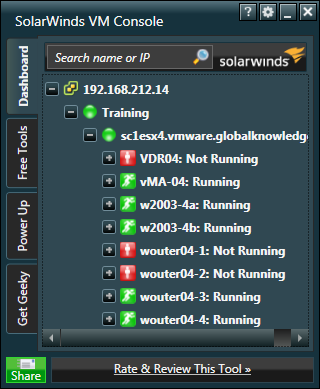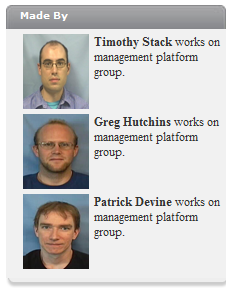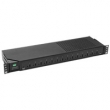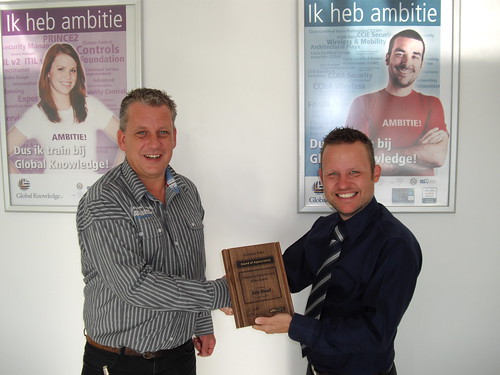If you’re attending the VMworld 2010 next week you might want to consider putting the following session on your most wanted list.
Session ID: BC8432
Session Title: SRM Futures: Host Based Replication
Host based replication (HBR) is the ability to replicate VM’s between dissimilar storage. Meaning for example, from an ESX local hard drive to a storage array in a different location. This technology will be in a future version of SRM and it will allow you to protect a remote location as if you had replicating storage arrays in common between it and your main datacenter. SRM will allow you to replicate individual VM’s as part of a protection strategy. This replication will be done without guest agents and is managed inside SRM. You will see screen shots, and learn the use cases that have driven this feature set. You will learn how to install, configure and use it.
Speakers: Patrick Tullmann; Senior Staff Engineer at VMware and Michael White; Senior Technical Marketing Architect BCDR at VMware
Thursday, August 26. 2010
SRM Futures: Host Based Replication
Wednesday, August 25. 2010
New Book: VMware High Availability Constructs By Duncan Epping and Frank Denneman
Pearson IT Certification has released the first sample chapter of the upcoming book "VMWare High Availability Constructs" written by Duncan Epping and Frank Denneman.
Duncan Epping is a Consulting Architect working for VMware as part of the Cloud Practice. Duncan works primarily with Service Providers and large Enterprise customers. He is focused on designing Public Cloud Infrastructures and specializes in bc-dr, vCloud and VMware HA. Duncan is a VMware Certified Professional and among the first VMware Certified Design Experts (VCDX 007). Duncan is the owner of Yellow-Bricks.com, one of the leading VMware/virtualization blogs worldwide (recently voted number 1 worldwide on vsphere-land.com) and co-author of the "vSphere Quick Start Guide" and "Foundation for Cloud Computing with VMware vSphere 4," which has recently been published by Usenix/Sage (#21 in the Short Topics Series). He can be followed on twitter at http://twitter.com/DuncanYB.
Frank Denneman is a Senior Consultant working for VMware as part of the Professional Services Organization. Frank works primarily with large Enterprise customers and Service Providers. He is focused on designing large vSphere Infrastructures and specializes in Resource Management and DRS in general. Frank is a VMware Certified Professional and among the first VMware Certified Design Experts (VCDX 029). Frank is the owner of FrankDenneman.nl an upcoming blog which has recently been voted number 14 worldwide on vsphere-land.com. He can be followed on twitter at http://twitter.com/FrankDenneman.
When configuring VMware High Availability (HA), two major decisions will need to be made. Will I enable Admission Control? And which Isolation Response will I select? This chapter will explain both concepts in depth and make you aware of the caveats and the impact of your decisions. After reading this chapter you will be able to select the correct Isolation Response and Admission Control policy based on your requirements and constraints.
This is Chapter 5 from the upcoming book.
SolarWinds has released the free VM Console
 The new SolarWinds free VM Console enables you to bounce your virtual machines without ever logging into VMware! Plus, you can track up/down status, take snapshots, and restart VMs even if you’re not a VMware administrator. Be a VM superhero with the ability to:
The new SolarWinds free VM Console enables you to bounce your virtual machines without ever logging into VMware! Plus, you can track up/down status, take snapshots, and restart VMs even if you’re not a VMware administrator. Be a VM superhero with the ability to:
- Shutdown & restart VMs without logging into vCenter or vSphere
- Take snapshots of your VMs before bouncing them
- Get end-to-end visibility into your VMware environment — from vCenter through ESX hosts to VM guests
- Track the up/down status of your VMs without logging into VMware apps
I just downloaded a new FREE network tool from SolarWinds which you might like. SolarWind's VM Console Free Tool lets you monitor, and restart virtual machines without logging into VMware vCenter or Vsphere! You can download it here: http://bit.ly/93WjRH
Tuesday, August 24. 2010
I’m awarded as the best freelance VCI of the quarter – Yeah
The first official VMware training course I’ve delivered was back in 2007. We were just shifting from ESX 2.5 to ESX 3.0 back then. In the early days I delivered just one training course a month and the rest of my time was filled up with consultancy. In the past few years the numbers of attendees just exploded. These days you will find vSphere within every company and there’s a much higher demand for VMware training courses. The number of VCPs have increased in a high rate as well. The nice thing about being in the training business “for so many years” is, that with every new version, you see some familiar faces back in the classroom.
But let’s jump to the present. At the beginning of this year VMware has announced the EMEA VCI of the Quarter award program. The award recognizes exceptional VMware Certified Instructors from the EMEA region. Potential candidates are nominated by VATCs having demonstrated a combination of consistent excellence in customer evaluation scores and an ability to help students make the most of their VMware technology. In addition candidates will be evaluated based on their contribution to the VCI community forums, early adoption of new training courses and a commitment to raising the quality of VMware’s education portfolio. Each quarter a VATC can nominate one directly employed and one independent VCI whom they have contracted with the nomination period. The VCIs nominated will undergo a thorough review process to be considered for the award. A panel that includes members of the EMEA VATC education team evaluates each nominee's technical expertise and contributions for the past 3 months. The panel considers the quality, quantity, and level of impact of the nominee's contributions.
I’m very lucky with Raymond Boelhouwer who works as a Business Development Manager over at Global Knowledge. He’s the one who has nominated me and says: Although Eric is a freelance instructor he has taught many advanced and new VMware courses for Global Knowledge in the last quarter. All his deliveries are granted high scores by the attendees even for first deliveries which are not easy to do. For an organization as Global Knowledge it is easy to work with Eric and you can trust a job well done.
So last month I received an email from Kevin Johnson – VMware’s Northern Region Education Manager congratulating me as the best VMware Certified instructor of the quarter.
The winner for the Independent VCI of the Quarter is Eric Sloof. This was a very easy selection to make. Eric has been very busy over the last 3 months and has delivered 14 classes over a wide range of subjects, two of these classes were LoL. Eric’s scores were also consistently high. Eric is also very active in the VCI community.
You can imagine that I’m very proud with being awarded as the Independent VCI of Q2 2010. This morning I’ve received the official "Award of Appreciation" plaque from Raymond Boelhouwer. I can only say one thing, many thanks to all, it was my pleasure.
Monday, August 23. 2010
vSphere 4.1 to 4.0 differences
vSphere 4.1 (DeepDive) Delta training.zip (8.9 MB)
Friday, August 20. 2010
Booting ESXi from iSCSI and PXE
In my previous post "Running the VMware vSphere Hypervisor stateless" I’ve explained how to setup an ESXi deployment server, but now we are going to take it one step further. To be able to save the ESXi configuration settings there’s a CCBoot feature available which is called “Write Back”. In this episode (HD) I’m going to show you how to enable “Write Back” for both the ESXi host and the CCBoot server. After rebooting the ESXI host the configuration will be preserved.
Running the VMware vSphere Hypervisor stateless
This video <- HD version - will show you how to create a stateless VMware vSphere Hypervisor formally known as ESXi and how to boot it trough PXE-iSCSI. Yesterday evening I finally succeeded in booting an ESXi 4.1 host with PXE and iSCSI. After firing the tweet, I’ve received a lot of responses asking me how I did it. In the video I’ll show you how to build your own staging server and the deployment of an ESXi 4.1 host. I’m not really a Linux guy so I had to create a Windows distribution server. In my search I’ve discovered a great little piece of software called CCBoot. This windows application enables a diskless boot of an OS with PXE and iSCSI. Diskless boot makes it possible for ESXi server to be operated without a local disk. The 'diskless' server is connected to a VMDK file over the network and boots up the hypervisor from the remotely located VMDK file which was created in VMware WorkStation. CCBoot is the convergence of the rapidly emerging iSCSI protocol with gPXE diskless boot technology. Remote boot over iSCSI, or CCBoot, pushes the iSCSI technology even further, opening the door to the exciting possibility of the diskless computer.
Here are the steps to set it up
The first thing to do is create a VMDK file with ESXi 4,1 in it, I’ve used VMware Workstation 7.1.
When ESXi 4.1 is installed we’re going to set-up the distribution server, go to http://ccboot.com and download CCBoot v1.9 Build 20100128 (5 users free version). When you’ve installed it, create an entry for you ESXi 4.1 host and you’re ready to run.
Wednesday, August 18. 2010
New Fling released on VMware Labs - VMware Auto Deploy
VMware Auto Deploy supports automatic PXE boot and customization of large numbers of ESXi systems. Auto Deploy allows rapid deployment and configuration of a large number of ESXi hosts. After a DHCP server has been set up, Auto Deploy PXE boots machines that are turned on with an ESXi image. Auto Deploy then customizes the ESXi systems using host profiles and other information stored on the managing vCenter Server system. You can set up the environment to use different images and different host profiles for different hosts.
 System Requirements
System Requirements
• ESX/ESXi system to install the virtual appliance on. This system must be able to connect to the vCenter Server system on which you want to create and store the host profiles.
• Static IP address to assign to the VMware Auto Deploy appliance during startup.
• vCenter Server system to manage the auto‐deployed ESX/ESXi systems and to store the host profiles.
• MAC address or asset tag of each ESXi system you want to PXE boot.
• DNS Server that maps IP addresses to host names. (Optional)
Quickstart instructions
1. Deploy the OVA file on an ESX/ESXi server. The autodeploy VM should have a NIC connected to the management network.
2. Boot the new VM.
3. Go to the VM's console and answer any questions.
4. If the management network has no DHCP server, login as vi-admin and run 'sudo deploy-cmd dhcpconfig'. Otherwise, consult the manual for setting up the DHCP server.
5. Network boot the machine to be used as an ESXi server. It should contact autodeploy and start booting ESXi.
Version: 1.0 | File size: 1.18GB | Date uploaded: 08/12/2010
The VCAP4-DCD Exam Blueprint Guide has become available
The VCAP-DCD is directed toward IT Architects and Consulting Architects who are capable of designing VMware solutions in a multi-site, large enterprise environment. They have a deep understanding both of VMware core components and their relation to storage and networking, and also of datacenter design methodologies. They also possess knowledge of applications and physical infrastructure, as well as their relationship to the virtual infrastructure.
VCAP-DCD Exam Blueprint
This blueprint is intended to provide information about the objectives covered by this exam, related resources, and recommended courses. The material contained within this blueprint is not intended to guarantee that a passing score will be achieved on the exam. VMware recommends that a candidate thoroughly understands the objectives indicated in this guide and utilizes the resources and courses recommended in this guide where needed to gain that understanding.
Tuesday, August 17. 2010
New - AnywhereUSB/14
 AnywhereUSB products are network-attached USB hubs that connect USB peripheral devices to a PC over a Local Area Network. The AnywhereUSB TS model also adds four RS-232 serial ports, enabling the mixing of USB and serial ports over the same network connection. Relocating the host PC to a remote location translates to smaller workstations, enabling deployment without a local PC in kiosks, ATMs, restaurant kitchens, manufacturing lines or any hostile or non-secure area where having a local PC is not practical.
AnywhereUSB products are network-attached USB hubs that connect USB peripheral devices to a PC over a Local Area Network. The AnywhereUSB TS model also adds four RS-232 serial ports, enabling the mixing of USB and serial ports over the same network connection. Relocating the host PC to a remote location translates to smaller workstations, enabling deployment without a local PC in kiosks, ATMs, restaurant kitchens, manufacturing lines or any hostile or non-secure area where having a local PC is not practical.
New 19'' Rack model
VMware ESX Server Using AnywhereUSB to Connect USB Devices





